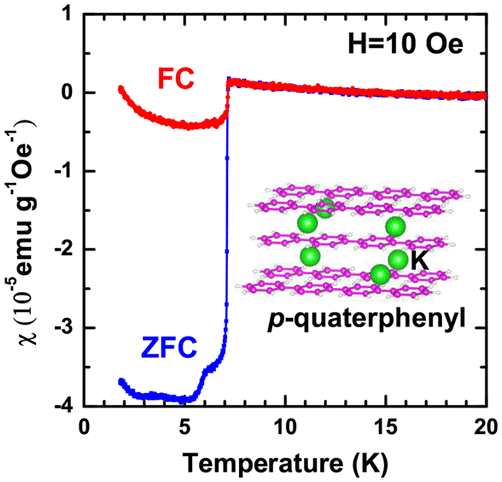120 K superconductivity in Potassium doped p-quaterphenyl- Dr. Xiaojia Chen
JANUARY 10, 2019
New work from a team of scientists led by Dr. Xiaojia Chen from HPSTAR and Haiqigng Lin of CSRC, found serials of superconducting materials in doped organic molecules. Their study has inspired a new round of research enthusiasm for scientists in the field of superconducting after the discovery of 203 kelvin in H3S. They proposed the chain link organic molecules are promising candidates for high-temperature superconductors. Their study is published on recent issue of JPCL and has been selected as the cover of the issue.
To explore more novel superconductors, the team of scientists targeted at oraganic molecules—aromatic hydrocarbon called para-quaterphenyl. Actually, the team led by Dr. Xiaojia Chen has realized a critical temperature of 123 kelvin in a similar aromatic hydrocarbon— para-terphenyl in 2017. Encouraged by the superconductivity with such high superconducting critical temperature in potassium-doped para-terphenyl, they want to examine such a possibility in para-quaterphenyl with one more phenyl ring than para-terphenyl. As expected, they obtained a serial of superconducting materials with critical temperatures ranging from 3.5 to 120 kelvin in potassium-doped para-quaterphenyl —KxC24H18.
They synthesized the doped samples by two simple ways. One is annealing the mixtures of C24H18 and potassium metal. The other is just mechanically mixing potassium and quaterphenyl without annealing. And then they made the magnetic measurements. From the so-called Meissner effect— one of essential characters for superconductivity, they discovered serials of superconducting phases with 3.5 to 120 kelvin critical temperature in the doped samples synthesized from annealing or just mechanically mixing methods. They found that the superconducting phase of 7.2 K can be repeated in several samples with superconductivity and seems to be the most stable phase. “In comparison with previous K-doped chain organic materials, the primary 7.2 K superconducting phase may be the common character in chain linking molecules”, said Dr. Xiaojia Chen.
 To understand the superconducting phases in the studied materials, they measured the Raman spectroscopy of the samples. “Our Raman measurements detected the formation of the so-called bipolarons in the doped samples”, explained Dr. Xiaojia Chen. “If we cooled the sample, the bipolarons will move like Cooper pairs in conventional superconductors and thus made the dopedsamplessuperconducting”.
To understand the superconducting phases in the studied materials, they measured the Raman spectroscopy of the samples. “Our Raman measurements detected the formation of the so-called bipolarons in the doped samples”, explained Dr. Xiaojia Chen. “If we cooled the sample, the bipolarons will move like Cooper pairs in conventional superconductors and thus made the dopedsamplessuperconducting”.
Their further X-ray diffraction pattern together with theoretical calculations attributes the low temperature superconducting phase (7.2kelvin) to two-electron doping. “While the 120 kelvin superconducting phase here is probably due to the higher doping concentration which is similar to the superconducting phase in doped p-terphenyl”, added Dr. Xiaojia Chen.
Caption: Temperature dependence of the magnetic susceptibility for KxC24H18 (sample no. 16) in the applied magnetic field of 10 Oe with field-cooling (FC) and zero-field cooling (ZFC).
为了探索更多新型的超导体,北京高压科学研究中心的陈晓嘉研究员带领的研究团队在钾掺杂的对四联苯样品中发现了系列超导相。他们通过退火过程或仅通过研磨工艺合成了钾(K)插层的对四联苯(C24H18)样品。通过对掺杂样品进行磁化率测量,发现了超导转变温度为3.5K至120K的超导相。超导临界温度为7.2 K超导相可以在退火和研磨的样品中多次重复,表明7.2K超导相是存在于链状有机分子中的普遍现象。他们进一步的拉曼散射测量实验确认了从金属到有机分子的电荷转移以及双极化子的形成。形成的双极化子可能是导致钾掺杂四联苯超导的关键原因。结合第一性原理计算,X射线衍射分析表明,7.2K的低温超导相是由于双电子掺杂,是最为稳定的相;而120K的高温超导相则对应于高掺杂含量。钾掺杂的对四联苯中超导电性的出现,支持了链式有机分子作为高温超导体的有希望的候选者之一。
